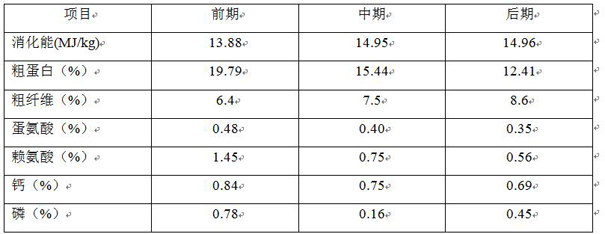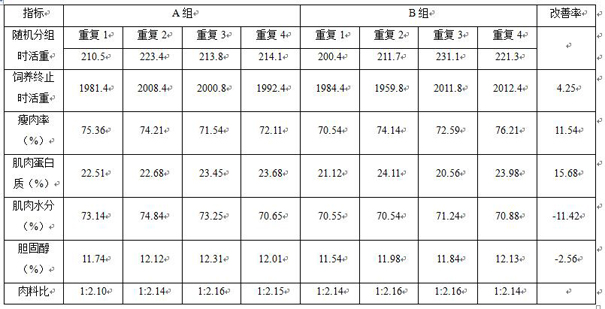A method for producing feed additives by using cassava residue and its alcohol waste mash
A feed additive and alcohol waste mash technology, applied in the field of feed additive preparation, can solve the problems of low utilization rate of raw materials, low content of organic matter such as protein, etc., and achieve the effect of short fermentation cycle, more surface active functional groups, and shortened fermentation cycle
- Summary
- Abstract
- Description
- Claims
- Application Information
AI Technical Summary
Problems solved by technology
Method used
Image
Examples
Embodiment 1
[0039] A. According to the ratio of parts by weight, take 4 parts of cassava dregs, mix them with 0.4g / L yeast extract, 0.10g / L urea, 1.4g / L peptone, and 20~30mg / L calcium sulfate in warm water at 60°C to prepare 25% (W / V) cassava residue solution;
[0040] B. Add 5 times the amount of loaded ionic liquid biochar to the cassava residue solution to react for 2 hours, then add reverse micelles-enzyme and 3 parts of alcohol waste mash and mix evenly, carry out raw material hydrolysis at 45°C for 30 minutes, 2000r / min Centrifuge at the bottom, get the upper phase solution, and obtain the slurry;
[0041] Described reverse micelle-enzyme is composed of: the alpha-amylase of 214IU / g cassava flour and the saccharification enzyme of 398IU / g cassava flour;
[0042] C. Adjust the initial pH of the paste to be 5.5, then inoculate 8%% of the composite bacteria liquid, and ferment for 48h at 50°C to obtain a mixed material; the composite bacteria liquid is Bacillus subtilis, Bacillus lich...
Embodiment 2
[0053] A. According to the ratio of parts by weight, take 10 parts of cassava dregs, mix them with 0.6g / L yeast extract, 0.14g / L urea, 1.6g / L peptone, and 30mg / L calcium sulfate in warm water at 80°C, and prepare 35% (W / V) cassava residue solution;
[0054] B. Add 10 times the amount of loaded ionic liquid biochar to the cassava residue solution to react for 3 hours, then add reverse micelles-enzyme and 5 parts of alcohol waste mash and mix evenly, and carry out raw meal hydrolysis at 55°C for 60 minutes, 2500r / min Centrifuge at the bottom, get the upper phase solution, and obtain the slurry;
[0055] Described reverse micelle-enzyme is composed of: α-amylase of 224IU / g cassava flour and saccharification enzyme of 694IU / g cassava flour;
[0056] C. Adjust the initial pH of the paste to 6.0, then inoculate 10% of the composite bacterial solution, and ferment for 72 hours at 60°C to obtain a mixed material;
[0057] D. Dry the mixed material to a solid material with a water co...
Embodiment 3
[0067] A. According to the ratio of parts by weight, take 8 parts of cassava dregs, mix them with 0.5g / L yeast extract, 0.12g / L urea, 1.5g / L peptone, and 28mg / L calcium sulfate in warm water at 68°C to make 30% (W / V) cassava residue solution;
[0068] B. Add 8 times the amount of loaded ionic liquid biochar to the cassava residue solution to react for 3 hours, then add reverse micelles-enzyme and 4 parts of alcohol waste mash and mix evenly, and hydrolyze the raw meal at 50°C for 50 minutes, 2000r / min Centrifuge at the bottom, get the upper phase solution, and obtain the slurry;
[0069] Described reverse micelle-enzyme is composed of: the alpha-amylase of 264IU / g cassava flour and the glucoamylase of 392IU / g cassava flour;
[0070] C. Adjust the initial pH of the paste to 6.0, then inoculate 9% of the composite bacterial solution, and ferment at 58°C for 65 hours to obtain a mixed material;
[0071] D. Dry the mixed material to a solid material with a water content of 8%, w...
PUM
 Login to View More
Login to View More Abstract
Description
Claims
Application Information
 Login to View More
Login to View More - R&D
- Intellectual Property
- Life Sciences
- Materials
- Tech Scout
- Unparalleled Data Quality
- Higher Quality Content
- 60% Fewer Hallucinations
Browse by: Latest US Patents, China's latest patents, Technical Efficacy Thesaurus, Application Domain, Technology Topic, Popular Technical Reports.
© 2025 PatSnap. All rights reserved.Legal|Privacy policy|Modern Slavery Act Transparency Statement|Sitemap|About US| Contact US: help@patsnap.com


